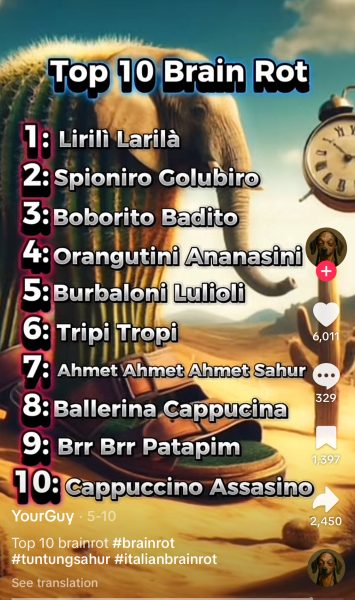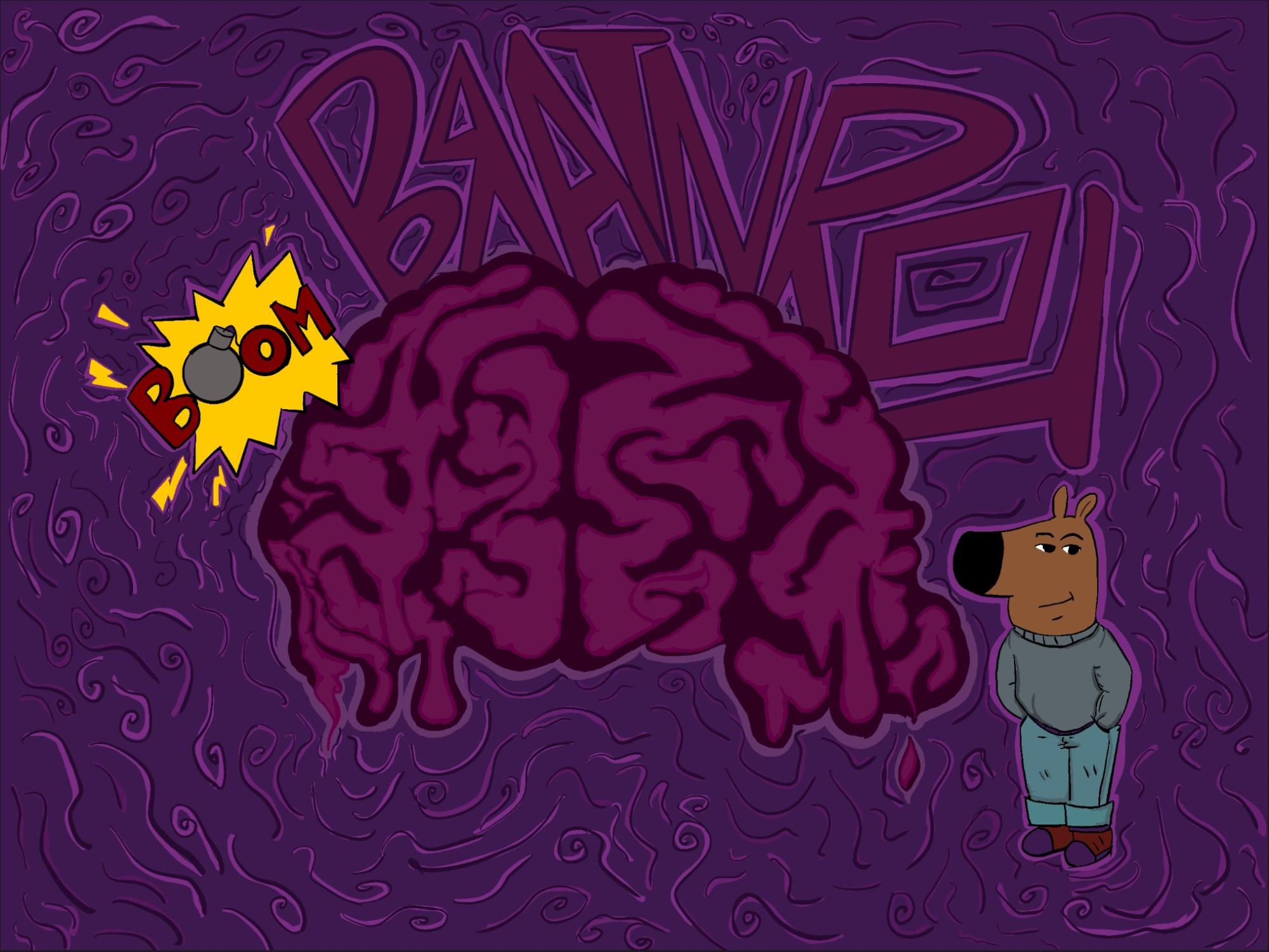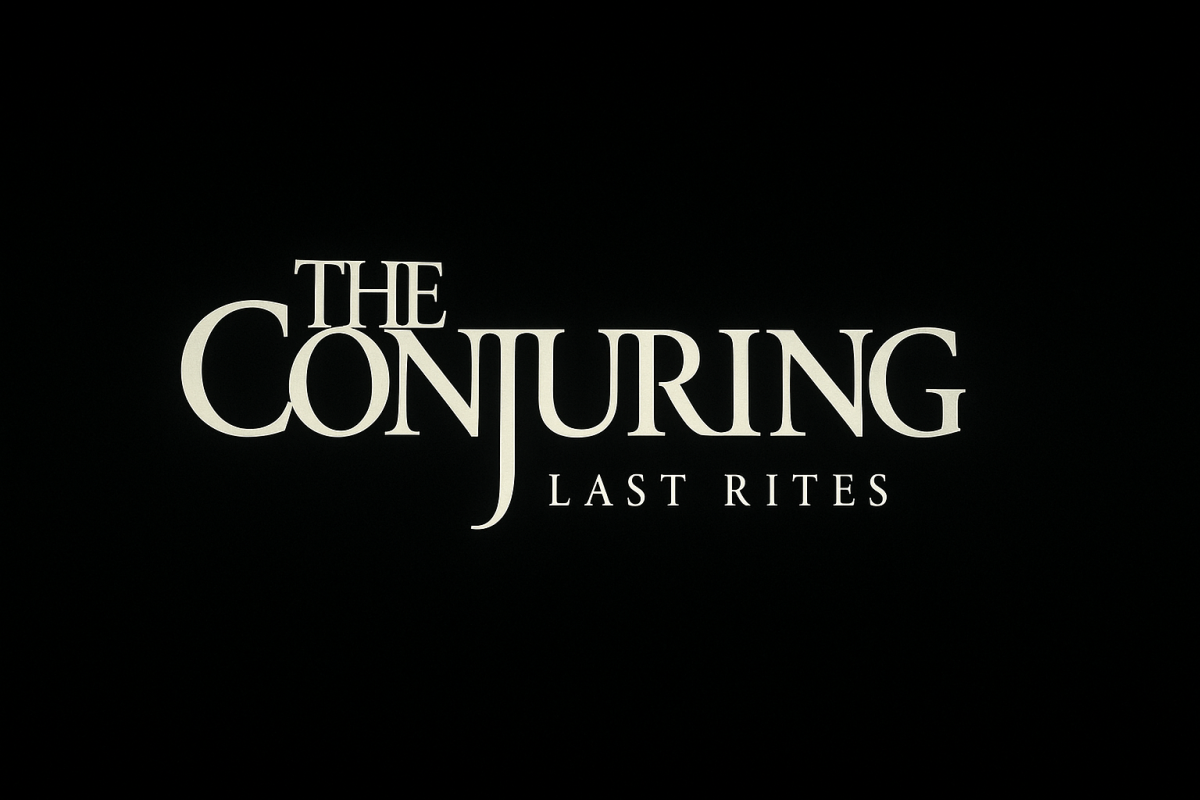Chat, I am so skibidi. According to Duke Dennis and baby Gronk, I got W rizz. These betas are NOT as looksmaxxed as I am bruh. Like no cap, sometimes when I’m learning how to become a high-value man, teaching my tralalaeritos how to say tralala, and waiting for my glorious king Lebron James to come and mew with me. I wonder how I got to know these slang terms in the first place. These nonsensical phrases are just one symptom of what we’ve all come to know as brain rot.
Brain rot, defined by Dictionary.com, is “a slang term used to describe the effects of being ‘perpetually online’ and consuming large amounts of low-value internet content.” Brain rot can also be explained as the inability to stop thinking about a topic or phrase that causes your brain to rot. This can be anything from Skibidi Toilet videos to the Sigma male grind set.
Brain rot has multiplied across billions of users and countless hours of content. The term even became so popular that it became the 2024 Oxford Word of the Year, with its usage skyrocketing by 230% between 2023 and 2024. Brain rot has become intertwined with our daily lives to the point that it begs the question: Has brain rot, this gradual deterioration of our ability to focus, think deeply, and engage with longer-form content, gone too far?

Brief 30-Second History of Brain Rot
Even though brain rot has become a relatively new term, its origins date back to an 1854 book by Henry David Thoreau, Walden. In his conclusions, Thoreau criticizes society’s tendencies to devalue complex ideas due to a general decline in mental and intellectual efforts. Thoreau specifically states, “While England endeavors to cure the potato rot, will not any endeavor to cure the brain rot—which prevails so much more widely and fatally?”
In 1899, journalist Julian Ralph warned the public of “brain-rot contagion” due to the increase in magazines in the US. He posited that “the number of people who think like birds, in little broken thoughts, will be greatly enlarged.”
But the brain rot we know of today, stems from social media platforms.
The earliest posts about brain rot on X, formerly Twitter, date back to 2007. In these posts, users described reality dating shows, video games, and “hanging out online” as either brain rot or causing brain rot. The usage of brain rot rapidly increased online in the 2010s and 2020s.
Now, in 2024, the term is often linked with Generation Alpha and Generation Z. Words like skibidi (a reference to the YouTube Shorts series Skibidi Toilet), rizz (short for charisma), and gyatt (one’s buttocks) are commonly labeled as brain rot. Brainrot is often consumed through short-form content.
The Phenomenon of Brain Rot
As the name suggests, short-form content is digital content that quickly captures the audience’s attention. The media ranges from videos to podcasts and even blogs. The primary purpose of posting these is to create content that is quick to engage and easy to digest and is more likely to capture and retain viewer interest. Short-form videos cater to this by delivering content in bite-sized pieces, making it easier for users to consume, enjoy, and share.
“I’ve been using TikTok since COVID had started,” explains senior Ariana Parra. “My fyp is a lot of musical theater and cute stuff to buy. I’m literally always on it and constantly sharing videos with my friends and family.”
We can largely attribute the success of short-form video to the fast-paced nature of online consumption. When COVID-19 required everyone to stay home, young generations turned to platforms like TikTok and Instagram to socialize with others or to pass the time. These platforms use algorithms designed to maximize engagement through continuous, personalized content streams to create powerful dopamine feedback loops. In doing so, short-form videos became popular, and these apps became essential.
“Most of my day I’m on TikTok or some sort social media,” Parra explains “And even though it’s just how the algorithm works, it has become a lot harder to put down my phone and just focus on my school work or extracurricular activities.”
The consequences of this shift are increasingly apparent. Attention spans are rapidly declining as users become accustomed to quickly swiping between unrelated content. When content fails to deliver immediate stimulation, the instinct to scroll or swipe for something new has become almost reflexive.
However, it is most apparent that fundamental changes have occurred in reading, learning, and information-processing habits.
Signs of Reaching a Tipping Point
“I’m teaching books at a much lower reading level than I used to; I have a cupboard filled with books that I can’t teach because you can’t cram The Handmaid’s Talem” explains English II, III, and IV, Jeanne Berrong. “It used to be that I would give assign a reading and give students a reading schedule, and about 80% of the people would keep up with the reading schedule. Now I’m lucky half keep up with the reading schedule.”
These shifts do not showcase the change in media preferences but a complete rewiring of cognitive pathways that will have lasting implications for future generations. Whether it’d be with processing information, solving problems or engaging with complex ideas the mental processes of children could be affected because of brain rot.
A study conducted by Frontiers in Psychology showed that short-form video addiction is associated with academic procrastination. Additionally, short-form video content lowered students’ attentional control, contributing to higher academic procrastination.
The study further explained that students suffering from short-form video addictions spend more time scrolling through their phones and continuously checking for news and messages from their friends. By doing so, they give in to their temptations and experience instant gratification, further postponing tasks like school work that are perceived as stressful, frustrating, or boring.
Not to mention, Berrong explains, “Students always assume there’s a right answer. There are few areas in your life that you’ll find where there is a definitively right and a definitively wrong answer.”
With the combination of wanting instant gratification and students believing there is only one correct answer to any given question, students have now turned to Artificial Intelligence (AI) to complete assignments and exams.
“Everybody wants to just get on the same page as everybody else,” Berrong explains further. “I think people are so far less sure of themselves than they ever were before. It forces people to naturally turn to AI as a crutch.”
However, these two are not the only factors contributing to students’ decline in academics. The invention of the internet has played a significant role in this.
Of course, when the internet was first introduced, people were excited about it, as it introduced a new era of global connectivity and unlimited access to information. Nicholas Carr, an American journalist and writer, noted that although the internet has many advantages, like getting information at light speed, it is slowly chipping away at our ability to concentrate and contemplate.
Furthermore, the way we read contributes to this chipping. The internet and modern technology promote an “efficient” style, which may weaken our ability to deeply read with bodies of text.
Deep reading is the process of thoughtful engagement with complex texts, such as analyzing a poem, connecting ideas across different texts, questioning assumptions and biases, and making annotation.
What makes modern brain rot more concerning is because of today’s digital transformation, it has completely reshaped cognitive environments within a single decade.
Is it inevitable?
It has become clear: the internet and brain rot have caused one of the biggest generational divides in recent history. Older generations, like the Baby Boomers and Gen X, view current digital habits with alarm, while younger generations, like Gen Z and Gen Alpha, see these behaviors as natural adaptations to an information-rich environment.
It has become clear to educators: students struggle with reading assignments that were once manageable, turn to AI for instant answers, and lose the ability to focus on complex tasks. What had started as a harmless way to connect with others and gain information quickly, has now become a much deeper problem; our ability to maintain attention and deep thinking is deteriorating.
But moving forward, the choice is ours. The question isn’t whether brain rot has gone too far but rather, it’s whether we’re ready to do something about it.









Ollie • May 30, 2025 at 12:56 pm
This is the best article ever written by man kind no cap ong